Assessor Calendar
| |
|
| Jan 01 |
Assessment of Real Property (Discovery, List, Value) 77-1301
|
| Jan 01 |
Assessment of Personal Property (Discovery, List, Value) 77-1201 |
| Jan 01 |
R R & Pub Serv req’d Report Non-Operating
Property to Assessor. 77-606 & 77-801 & Calendar
for Railroads & Public Service Entities. |
| Jan 01 |
Effective Date for Filing: Homestead Exemption Claimants MUST be (a) Owner of Record and (b) Occupy the homestead. (c) MUST be 65 or older.(d) Effective Date of Disability and Filing Status. 77-3502 77-3505 |
| Jan 15 |
Mobile Home Court Owner et al files Report w Assessor 77-3706 |
| Jan 31 |
Gov’l Subdivisions provide Assr Off w COPIES OF LEASES or descriptions of Leased property. 77-202.11
|
| Jan 31 |
Deadline for county Board of Equalization to petition the Tax Equalization & Review Commission for use of a different approach to value rent-restricted housing projects. (LB 356) 77-1333
|
| Feb 01 |
Assessor makes recommendations on permissive exemption applications Form 451. To Board of Equalization. Notice must be published in the paper, ten days prior to consideration of applications by the B O E that a list of organizations seeking permissive exemptions, legal descriptions, and Assessor
recommendations is available in the Assessor’s Office. 77-202.01 |
| Feb 01 |
Statements of Reaffirmation Form 451A do not need to be approved by the BOE only by Assessor. 77-202.01
|
| Feb 01 |
Assr issues notice of approval / denial Beginning Farmer Exemption Form 1027 77-5209.02 |
| Feb 01 |
Aircraft Report filed with Assessor. 77-1250.02
|
| Feb 01 |
Last day P.T.A. provide counties w Printed Claim Forms and Address Lists of prior year applicants. 77-3510
|
| Feb 01 |
First day for claimants to file NE Homestead Exemption App or Certification of Status. May fall on Feb 2 or 3 if Feb 1 is on Sat or Sun. 77-3512, 77-3513, 77-3514 |
| Feb 28 |
Seeking Separate Taxation of IOLL &
LAND File Form 402 Improvements on Leased Land Assessment Application 77-1376
|
| Mar 01 |
Certify to P.T.A whether or not Ag & Hort Land are influenced by prices outside of the typical ag-hort land market. REG 17-003.03
If Special Valuation is used, must file specific information w P.T.A.. REG 11-005.04
|
| Mar 01 |
Improvements owner on LEASED PUBLIC LAND may file Form 402P Improvements on Leased Public Land Assessment Application 77-1374
|
| Mar 01 |
ASSR notifies governmental subdivisions of intent to tax property not used for public purpose
and not paying an in lieu tax. 77-202.12
|
| Mar 01 |
PTA submits report of active TIF to the legislature see Research Reports on web site. 18-2117.01
|
| Mar 16 |
Deadline for written request for
Extension of Time from PTA to file the County
Abstract of Assessment
for Real Property (Form 45) and the AVU
Directive 09-1 & 77-1514
|
| Mar 19 |
Must inspect-review portion of real property parcels in county so that all real property parcels are
inspected-reviewed no less than every 6 years. March 19, 2014 completes first 6-Year cycle 77-1311.03
|
| Mar 19 |
Complete the County Abstract of Assessment for Real Property (Form 45) with the PTA (and the Assessed Value Update (AVU)) 77-1301
|
| Mar 19 |
Certify the County Abstract of Assessment for Real Property (Form 45) with the PTA (and the Assessed Value Update (AVU)) 77-1514
|
| Aft Mar 19 |
Overvaluation or Undervaluation. After March 19 and before July 25 (Aug 10 when extension) report to B.O.E. any overvalued or undervalued property. 77-1315.01
|
| Anytime |
Duty to report to BOE all real property omitted from the assessment roll for the current or any former year except when such real property has changed ownership otherwise than by will,
inheritance, or gift. 77-1317, 77-123, 77-124,
|
| Anytime |
Correct the tax rolls as provided in section 77-1613.02 for any real property listed on the Assessment roll but omitted from the tax
roll. 77-1316.01
|
| Anytime |
BOE may meet at any time for correction of clerical errors defined in 77-128. 77-1507 (Clerical error means transposition of numbers, mathematical error, computer malfunction causing programming and printing errors, data entry error, items of real property other than
land identified on the wrong parcel, incorrect ownership, or certification of an incorrect valuation
to political subdivisions.) 77-128
|
| Mar 25 |
Assessorr may submit written comments to P.T.A. that become part of R & O REG 17-003.04
|
| Apr 01 |
If homestead exemption notices mailed on or before Feb 01 did not contain all of The statutorily required information a 2nd notice must be sent on/before April 01. 77-3513, 77-3514
|
Apr 01
|
If homestead exemption notices mailed on or before February 1 did not contain all of The statutorily required information, a 2nd notice must be sent on or before April 1 77-3513 77-3514
|
Apr 01
|
Last day to send a RE-APPLY reminder to eligible previous year homestead Exemption
applicants. 77-3513, 77-3514
|
| May 01 |
First-1/2 Real & Personal Property Taxes for Prior Year become delinquent 77-204
|
| May 01 |
Deadline File Ne Personal Property Return & Schedule w/o penalty. 77-1229
|
| May 01 |
Deadline w Agreement, File Form 775P &/or Form 312P Claim for P P Exemption & supporting schedules 77-4105 (2)(c ) & 77-5725 (7)(c)
|
May 01
|
First ½ of real & personal property taxes for prior assessment year become delinquent If unpaid in counties with less than 100,000 population. 77-204
|
| May 01 |
Deadline Physician’s Certificate for LATE
Homestead Exemption filing FORM 458L In counties less than 100,000 population. 77-3512, 77-3513, 77-3514.01
|
| May 15 |
Last Day for T.E.R.C. to adjust the valuation
of a class/sub-class of real property. 77-5028
|
| May 30 |
Deadline TREA & ASSR file FORM 458X
amended homestead exemption summary Certificate for tax loss previous year (NOTE: 458X may be filed reflecting changes based on income ANYTIME up to 3 years after the exemption year.) 77-3523 and 77-3517
|
| May 31 |
School system of County Official may request
corrections to school adjusted valuation due to tax list corrections of the prior assessment year. 79-1016
|
| Jun 01 |
Assr publishes a notice in the newspaper CERTIFYING the (a) assessment roll is Complete, (b) notices of valuation changes have been mailed, and (c) stating the final date for filing protests with the B O E 77-1315
|
| Jun 01 |
Freeholder files petition with local board (Assessor, Treasurer & Clerk) to have school districts changed which is contiguous to that land. 79-458(1)
|
| Jun 1 - Jul25 |
B O E holds hearings to review property valuation PROTESTS 77-1502
|
| Jun 5
|
If T.E.R.C. ordered changes, Assessor re-Certifies the Abstract with PTA 77-5029
|
| Jun 6 |
Assr mails assessment sales ratio stats given
by TERC to media & posts in office. 77-1315
|
| Jun 15 |
Assr prepares a PLAN OF ASSESSMENT report for the next 3 years. 77-1311.02
|
| Jun 30 |
Deadline for filing Homestead Exemption App
or Certification Of Status, Form 458 77-3512
|
Jun 30
|
Deadline Late Application and Written Request B O E for Waiver of Late Filing for permissive
exemptions Forms 451 or 451A 77-202.01
|
| Jun 30 |
Deadline. SPECIAL VALUATION application Ag-Hort use. Form 456 77-1345
|
Jun 30
|
Deadline file property valuation protest with
County Clerk (for BOE) 77-1502
|
Jun 30
|
Deadline P P Valuation Protest Returns filed
Jan 1 thru May 1 with County Clerk 77-1502
|
Jun 30
|
Deadline. SPECIAL VALUATION application Ag-Hort use. Form 456 77-1345
|
| Jun 30 |
Last day to add Personal Property value with a 10% Penalty 77-1233.04
|
| Jul 01 |
Added Personal Property is subject to 25%
Penalty from this date forward. 77-1233.04
|
| Jul 15 |
ASSR approves-denies SPECIAL VALUATION apps; notifies applicant before July 22 77-1345.01
|
| Jul 20 |
If deadline extension granted by B O E, new
Deadline for filing Homestead Exemption App or Certification Of Status, Form 458 77-3512
|
| Jul 20 |
County Assr electronically certifies the County Personal Property Abstract Report to the P.T.A. (beginning 2016) (LB 259) 77-1514
|
| Jul 22 |
Assr notifies applicants of special
valuation of approval or disapproval 77-1345.01
|
Jul 22
|
BOE sends notice of value change on Special Valued land if no notice previously Sent by Assr prior to June 1.
|
| Jul 26 |
BOE petition T.E.R.C. for an adjustment to the valuation of a class/sub-class of property. (NOTE: If protest period extended, BOE waives right to petition.) 77-1504.01; 77-1502
|
| Jul26-Aug24
|
Taxpayer file appeal of BOE to T.E.R.C. 77-1510
(NOTE: may file appeal to T.E.R.C. on/before Sep 10 for extended counties)
|
| Jul 31 |
Last day ASSR send Notice of Rejection of Homestead Exemption Form 458R 77-3516
|
Jul 31
|
Assr files 3-Year Plan Of Assessment with the BOE 77-1311.02
|
Jul 31
|
Last day for Annexations Pol Subs for taxable value in current year. 13-509(NOTE: Annexation by
Pol Subs on/after Aug 1 considered next year
taxable)
|
| Aug 01 |
Last day FORWARD approved Homestead Exemption Application or Certification of Status, Form 458, with Disability Certifications, Form 458B, or Veterans Affairs Letters, and Form 458 Schedule I – Income Statements to Tax Commissioner. 77-3517
|
Aug 01
|
Assr reviews ownership & use of all cemetery real property and reports to BOE. 77-202.10
|
Aug 01
|
Last Day Pol Sub submit request for LEVY ALLOCATION to BOE or CITY. 77-3443
|
Aug 01
|
CITY or Community Redevelopment Authority (CRA) files NOTICE to Divide Tax For Comm Redevel Project (T I F) with the County Assr. 18-2147(3)
|
| Aug 01 |
PTA certifies to T.E.R.C. the ASSR implemented the equalization orders. 77-5029
|
| Aug 01 |
Tax Commissioner certifies Exempt P P for Employment & Investment Growth Act Form
775P and Nebraska Advantage Act Form
312P ; notifies Taxpayer and County Assessor. 77-4105; 77-5725(c)
|
| Aug 02 |
County Clerk mails notice of B O E decisions
to protestors. 77-1502(4)
|
| Aug 10 |
Last Day T.E.R.C. act on BOE petition.. 77-1504.01
|
| Aug 10 |
T.E.R.C. sets equalization rate for real property of Centrally Assessed Railroads and Public Service
Entities. 77-5022
|
| Aug 10 |
PTA certifies distributed taxable value of Centrally Assessed Property to Assessor. 77-5030
|
| Aug 15
|
Approved Freeholder Petition filed on/before June 1 of current year become Effective. 79-458(3)
|
Aug 15
|
ASSR approves/denies Homestead Exemption based on Ownership or Occupancy From Jan 1 through Aug 15 77-3502
|
Aug 15
|
Deadline for Homestead Exemption to file an Application for Transfer Form 458T 77-3509.01
|
| Aug 20
|
Certify taxable valuations & growth value to political subs. Certify current values For each T I F project to City or Community Redevelopment Authority (CRA) and to Treasurer 13-509; 13-518; 18-2148
|
| Aug 20
|
If T.E.R.C. orders changes for B O E petitions, ASSR re-certifies ABSTRACT (Form 45) to PTA 77-1504.01
|
| Aug 24
|
Last day taxpayer appeals B O E decision to T.E.R.C. 77-1510
|
| Aug 25 |
ASSR certifies School District Taxable Value Report to P.T.A.. 79-1016
|
| Aug 31
|
Annual Inventory County Personal Property in custody of Assessor 23-347
|
Sep 01
|
Second-1/2 Real & Personal Property Taxes for Prior Year become delinquent 77-204
|
Sep 01
|
After B O E value adjustments, Assr determines AVERAGE RESIDENTAL VALUE For homestead exemption and certifies the Homestead Exemption Certification of Average Assessed Value of Single-Family Residential Property Form 458V to PTA 77-3506.02
|
Sep 01
|
No LEVY allocation change after this date except by agreement by LEVYING Authority and Political
Subdivision. 77-3443
|
| Sep 10 |
Where B O E extended Protest Hearings, Last day Protestor appeal BOE decision to T.E.R.C 77-1510
|
| Sep 15 |
B O E last day for decision on Under or Over Valued Property 77-1504
|
| Sep 15 |
P.T.A. certifies the amount of Real Property TAX CREDIT to State Treasurer and to each county. 77-4212
|
| Sep 20 |
BUDGETS must be Final and Filed with the levying board and State Auditor. 13-508
|
| Sep 30 |
ASSR may amend the School District Taxable Value Report for corrections or errors 79-1016
|
| Sep 30 |
BOE publishes list of Permissive Exemptions and sends list and proof of publication To P.T.A. 77-202.03 (5)
|
| Oct 1 |
Rent-Restricted Housing Projects file INCOME &
EXPENSE STATEMENTSs and any Other Info requested by Assr with both Assr & Tax Commissioner. (LB 356). 77-1333
|
| Oct 1 |
Rent-Restricted Housing Projects file INCOME &
EXPENSE STATEMENTS and any Other Info requested by Assr with both Assr & Tax Commissioner. (LB 356). 77-1333
|
| Oct 9 |
Last Day for voter approval to exceed LEVY limits or final allocation at election or “town hall meeting.” 77-3444
|
| Oct 10 |
P.T.A. certifies the school adjusted valuations to
Dept of Ed, School systems, and County Assessors. 79-1016
|
| Oct 10 |
P.T.A.certifies the school adjusted valuations to
Dept of Ed, School systems, and County Assessors. 79-1016
|
| Oct 13 |
Political Subs forward resolution setting a tax request different from the prior year to County Clerk 77-1601.02
|
| Oct 15 |
LEVY DATE Last day
B O E to set tax rates/levies 77-1601
|
| Oct 15 |
Last Day taxpayer file B O E appeal to T.E.R.C. re under or over valued property 77-1504
|
| Oct 31 |
Assr submits 3-Year Plan and any Amendments to Dept of Revenue 77-1311.02
|
| Nov |
Rent-Restricted Hsg Projects Valuation Committee meets annually in November to Examine Rent-Restricted Hsg Projects statements & expense reports in order to Calculate a Market-derived Capitalization Rate. (LB 356) 77-1333
|
| Nov 1 |
Last Day Tax Comm certifies qualified Homestead Exemption income determinations to the County
Assessor. 77-3517
|
| Nov 5 |
Last Day B O E correct levies/tax rates as a result
of clerical error. 77-1601
|
| Nov 10 |
Deadline school sys file appeal with Tax Comm
for the School Adjusted Value Certified for use in the school aid formula. 79-1016
|
Nov 10
|
School Dis or County Off deadline file written
request w Tax Comm correction school adjust
value due to clerical error or SPECIAL
VALUATION ADDITIONS 79-1016 |
| Nov 15
|
Deadline. EXEMPT TO EXEMPT. For an org to file a permissive exempt application For property it purchased between July 1 and levy date previously exempt. 77-202.03
|
| Nov 22 |
Deliver Signed WARRANT For Collection Of Taxes To Treasurer having completed the tax list for real and personal property. 77-1616
|
| Nov 30 |
Deadline ASSR & TREA certify to P.T.A. Homestead Exemption Summary Certificate Form
458S for tax loss due to homestead exemptions for the current tax year.(Both signatures required) 77-3523
|
| Nov 30 |
Deadline for ASSR & TREA certify electronically the Personal Property Tax Loss Summary Certificate for personal property exemption for locally assessed property(beginning 2016) (LB 259) 77-1239
|
| Dec 01 |
Assr files Certificate of Taxes Levied (CTL)
with P.T.A. 77-1613.01
|
| Dec 01 |
City or CRA (Community Redevelopment Authority) files report with P.T.A. for approved tax
increment financing projects (T I F) 18-2117.01
|
| Dec 01 |
Last day Property Tax Administrator (P.T.A.)
forwards copy of Rent-Restricted Housing Projects annual report by the Valuation Committee to ASSR for Cap Rate In determining value of rent-restricted
housing projects. (LB 356) 77-1333
|
| Dec 01 |
Deadline for ASSR to ensure sales data in state sales file is accurate and all sales Are included. Directive 12-05 |
| Dec 31 |
Real Property & Personal Property Taxes Due – LIEN DATE 77-203
|
| Dec 31 |
Permissive Exemption Application deadline For newly acquired property or in years divisible by four, file Exemption Application Form 451
For interim years, file Exemption Application Form 451A
For example: File Form 451A by Dec 31, 2014 to
reaffirm for assesssmt year 2015 File Form 451 by Dec 31, 2015 to apply for assessmt year 2016 (which is divisible by 4) 77-202.01; 77-202.03
|
| Dec 31 |
Deadline. Form 1027 Exemption App Qual Beginning Farmer / Livestock Producer Must be filed with Assr on-before Dec 31 in the year preceeding year applied for.Exemption is for
Personal Property tax on ag-hort machinery & equipment. 77-202.01; 77-5208; 77-5209.02
|
Dec 31
|
Deadline for taxpayer/owner to file Vacant or
Unimproved Lot Application, Form 191To elect to have 2 or more lots held for sale/resale to be treated as one parcel for Property tax purposes. 77-132
|
Dec 31
|
Owner petition T.E.R.C. determine taxable status of real property – if a failure to give proper notice prevented the timely filing of a protest or appeal for exempt property.
|
Dec 31
|
Last Day for Tax Commissioner to review income and other information for the third Preceding year and take any action. 77-3517
|
| May 01 & Sept 01 |
First 1 / 2 and 2nd 1 / 2, Real and Personal Property Taxes for prior assessment year Sept 01 become delinquent, if unpaid, in counties with a population less than 100,000 pop’n. 77-204
|
Marriage License
Requirements for a marriage license issued by Buffalo County:
| 1. |
Applicants must be at least 17 years of age to be married in the state of Nebraska. Parental consent is required for applicants who are 17 or 18 years of age. The parental consent forms are available at the County Clerk's office.
|
| 2. |
Both applicants must appear together at the County Clerk's office between the hours of 8 a.m. and 4:30 p.m. on weekdays.
|
| 3. |
The fee for a marriage license is $25.00, CASH ONLY. (See our ATM locations in the courthouse.) |
| 4. |
Must present photo identification. A valid driver's license from any U.S. state, Nebraska ID card, U.S. Passport, U.S. Military card, or a Foreign passport are acceptable forms of photo identification. All documents will be in English or translated by a certified court translator. Proof of citizenship or immigration status is neither relevant or required.
|
| 5. |
Need to know birthplace for both applicants. |
| 6. |
Need to know full names and birthplaces of parents.
|
| 7. |
If a social security number has been issued to the applicants, we will need that information. The issuance of a social security number to either applicant is not required to obtain a Marriage License.
|
| 8. |
If there were any previous marriages we will need to know how they ended (divorce, annulment or death) and the date the divorce was final or the date of death. If there is a previous divorce, a new license will not be issued and you cannot remarry until at least six (6) months and one (1) day have passed from the date the Decree was signed by the judge and filed with District Court.
|
| 9. |
The Marriage License is good for one year from the date of issuance and can be used in any County in Nebraska.
|
| 10. |
All marriage licenses obtained in Nebraska are public record.
|
All marriage licenses obtained in Nebraska are public record.
For information about scheduling the Buffalo County Court Magistrate to conduct a marriage ceremony, contact Sharmin Gonzales at sharmin.gonzales@nejudicial.gov or 308-236-1229.

Certified copy of a Buffalo County marriage license
To Receive a Buffalo
County certified marriage license either stop by the clerk’s office with $9.00
cash or send a $9.00 money order and the following information:
- Name of Applicant A/Groom
- Name of Applicant B/Bride
(including maiden name)
- Date of marriage (Must be issued from Buffalo County)
Mail to:
Buffalo County Clerk
PO Box 1270
Kearney, NE 68848-1270
If you have any questions, contact us by:
Phone: (308) 236-1226
E-mail: clerk@buffalocounty.ne.gov

Changing name after
the wedding
This is a personal decision. You may choose to keep your name but if you decide to change your name legally, you should do the paperwork as soon as possible after you're married (or after your honeymoon). Many entities will require you to present a certified copy of your marriage license as proof of legal status to make your name change. Photocopies and keepsakes are not recognized by most government offices as proof of marriage. The following is a list of what may need to be updated.
- Social Security Card (require certified copy)
- Bank, credit union, and investment accounts
- Vehicle title/registration
- Driver's license (require certified copy)
- Mortgage
- Homeowner's insurance
- Life insurance
- Car insurance
- Medical and dental records
- Credit cards and files
- Deeds and property titles
- Passport
- Voter registration card
- IRS forms
- Church records
- Mail and newspaper subscriptions
- Employer/payroll
- Post office
- Your attorney (to update legal documents, will)
- Military records
- Utilities/Subscriptions
Return to top
THIS INFORMATION IS SUBJECT TO CHANGE WITHOUT FURTHER NOTICE.
Wireless Emergency Alerts
To enhance public safety, a free Wireless Emergency Alerts service is rolling out. WEA (pronounced “wee”) messages are text-like alert messages received by your mobile device during an emergency in your area. The purpose of WEA is to provide an increasingly mobile American public with a free and fast way to receive critically important information.
Frequently Asked Questions:
Why is this important to me?
Alerts received at the right time can help keep you safe during an emergency. With WEA, alerts can be sent to your mobile device when you may be in harm’s way, without need to download an app or subscribe to a service.
What are WEA messages?
Wireless Emergency Alerts (WEA) are emergency messages sent by authorized government alerting authorities through your mobile carrier. Government partners include local and state public safety agencies, FEMA, the FCC, the Department of Homeland Security, and the National Weather Service.
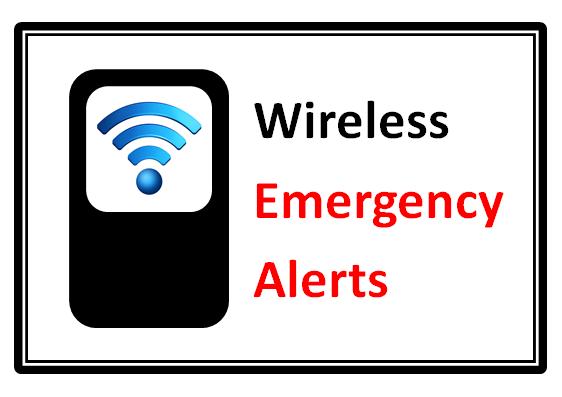
What types of alerts will I receive?
- Extreme weather, and other threatening emergencies in your area
- AMBER Alerts
- Presidential Alerts during a national emergency
What does a WEA message look like?
WEA will look like a text message. The WEA message will show the type and time of the alert, any action you should take, and the agency issuing the alert. The message will be no more than 90 characters.
How will I know the difference between WEA and a regular text message?
WEA messages include a special tone and vibration, both repeated twice.
What types of WEA messages will the National Weather Service send?
- Tsunami Warnings
- Tornado and Flash Flood Warnings
- Hurricane, Typhoon, Dust Storm and Extreme Wind Warnings
- Blizzard and Ice Storm Warnings
What should I do when I receive a WEA message?
Follow any action advised by the emergency message. Seek more details from local media or authorities.
Will I receive a WEA message if I’m visiting an area where I don’t live, or outside the area where my phone is registered?
Yes, if you have a WEA-capable phone and your wireless carrier participates in the program. For information about which mobile devices are WEA-capable and carrier participation, please visit http://www.ctia.org/wea or contact your wireless carrier.
What if I travel into a threat area after a WEA message is already sent?
If you travel into a threat area after an alert is first sent, your WEA-capable device will receive the message when you enter the area.
When will I start receiving WEA messages?
It depends. WEA use begins in the spring of 2012, but many mobile devices, especially older ones, are not WEA-capable. When you buy a new mobile device, it probably will be able to receive WEA messages. For information about which mobile devices are WEA-capable, please visit http://www.ctia.org/wea or contact your wireless carrier.
Is this the same service public safety agencies have asked the public to register for?
No, but they are complementary. Local agencies may have asked you to sign up to receive telephone calls, text messages, or emails. Those messages often include specific details about a critical event. WEA are very short messages designed to get your attention in an emergency situation. They may not give all the details you receive from other notification services.
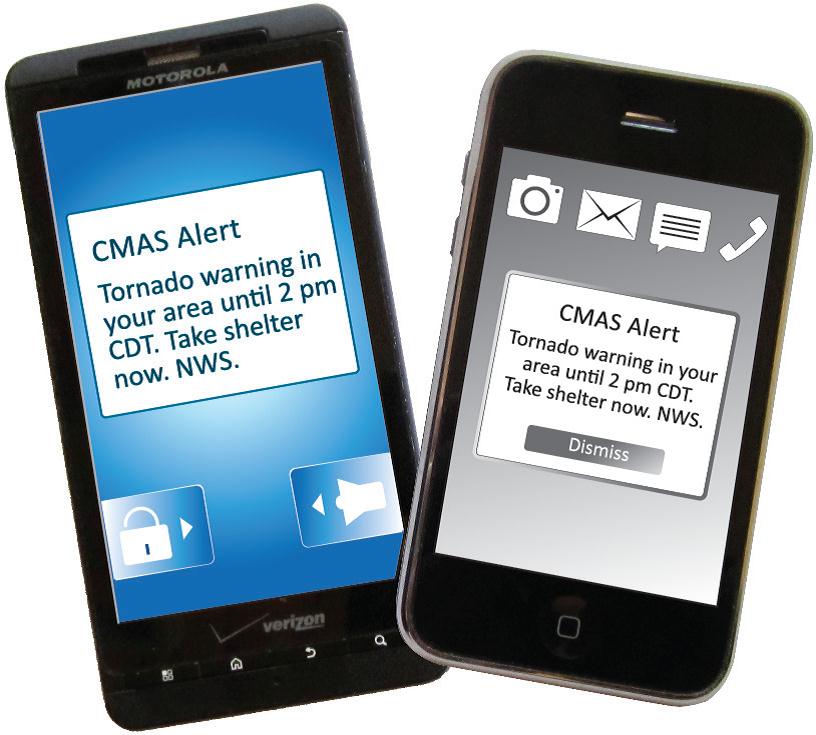
Will I be charged for receiving WEA messages?
No. This service is offered for free by wireless carriers. WEA messages will not count towards texting limits on your wireless plan.
Does WEA know where I am? Is it tracking me?
No. Just like emergency weather alerts you see on local TV, WEA are broadcast from area cell towers to mobile devices in the area. Every WEA-capable phone within range receives the message, just like every TV shows the emergency weather alert if it is turned on. TV stations, like WEA, don’t know exactly who is tuned in.
Will a WEA message interrupt my phone conversations?
No, the alert will be delayed until you finish your call.
How often will I receive WEA messages?
You may receive frequent WEA messages during an emergency. Message frequency depends on the number of imminent threats to life or property in your area.
If, during an emergency, I can’t make or receive calls or text messages due to network congestion, will I still be able to receive a WEA message?
Yes, WEA messages are not affected by network congestion.
What if I don’t want to receive WEA messages?
You can opt-out of receiving WEA messages for imminent threats and AMBER alerts, but not for Presidential messages. To opt out, please refer to instructions from your wireless carrier or visit http://www.ctia.org/wea for more information.
How will I receive alerts if I don’t have a WEA-capable device?
WEA is one of many ways you can receive emergency notifications. Other sources include NOAA Weather Radio, news media coverage, the Emergency Alert System on radio and TV broadcasts, social media, and other alerting methods offered by local and state public safety agencies. Your best use of WEA is to immediately seek additional information about the imminent threat impacting your area.
A flyer with more information about
Wireless Emergency Alerts is available.
Historical Information
Buffalo County is one of only two counties in Nebraska that derived its name from an animal. Years before this area along the Platte River would become a county, large herds of buffalo grazed the river valley and the rolling plains to the north. When it came time to organize the county, it seemed fitting to name it after the animal that once roamed the area freely.
The boundaries of Buffalo County were established by the Territorial Legislature in 1855. The county was officially organized in 1864, three years before Nebraska was admitted in the Union.
Two transportation lines can be credited with the early development of the area -- the Mormon Trail and the Union Pacific Railroad.
The first settlers in this area were said to be Mormons who had headed west along the trail in 1858. But a fierce war between the Cheyenne and Sioux tribes forced these early settlers to temporarily abandon the area. When the fighting subsided, the settlers gradually returned. In time, more and more settlers came to the area because of the rich Platte River Valley and the fertile soil that could be found in the surrounding hills.
With the coming of the railroad in the 1860s, Buffalo County would continue to develop. One of the stations that sprang up was Kearney, the county seat. Originally named Fort Childs, it was later renamed Kearney Junction and finally shortened to Kearney. Moses H. Sydenham, one of the early pioneers in the county, founded a newspaper in this young settlement and used the publication to promote his idea that Kearney, with its central location, should become the capital of the United States.
Hardships such as hot, dry weather and severe blizzards were not uncommon for the early residents of the county. But the most serious challenge faced by those who worked the land was the damage done by waves of grasshoppers that swarmed over the area in the mid 1870s.
More than 115 years later, Buffalo County is a thriving agricultural and industrial area. It also pays an important role in the state's higher education system, with the University of Nebraska at Kearney located in the county seat.
The Buffalo County Courthouse
Virtually every county in Nebraska has had a county seat "fight". Gibbon was designated as the original county seat of Buffalo County, and a courthouse was constructed at that location. In 1874, after considerable agitation for the relocation of the county seat, an election was held, and a majority was cast for the relocation of the county seat at Kearney. The incident which followed the results of that election is often referred to as "stealing the courthouse records." With the results of the election already in, the County Clerk, Joseph Scott, and his deputy, F.G. Keens, loaded the county records in a farm wagon, considerably after normal business hours and arrived in Kearney about 2:00 a.m. Mr. Keens stood guard over the records for the rest of the night. The Union Pacific Railroad donated a site for a new courthouse, and built a frame building which was not occupied until January of 1886. This building served as the Buffalo County Courthouse until a new county courthouse was built and completed in 1890. The frame courthouse was then moved to a new location on First Avenue and served first as a WCTU hospital and later as a home for the Veterans of Foreign Wars.
Family Disaster Plan
Disaster can strike quickly and without warning. It can force youto evacuate your neighborhood or confine you to your home. What would you do if basic services--water, gas, electricity or telephones--were cut off? Local officials and relief workers will be on the scene after a disaster, but they will not be able to reach everyone right away, so it is important for you to develop a plan for you and your family.
Families can, and do, cope with disaster by preparing in advance and working together as a team. Follow the steps below to create your family's disaster plan. Knowing what to do is your best protection and your responsibility.
Where will your family be when disaster strikes? They could be anywhere--at work, at school or in the car.
How will you find each other? Will you know if your children are safe?
4 STEPS TO SAFETY
1. Find Out What Could Happen to You
Contact the Emergency Management office or the Ft. Kearney Chapter of the American Red Cross.
- Ask what types of disasters are most likely to happen in Kearney and the surrounding area. Request information on how to prepare for the different types of emergencies that could occur.
- Learn about the existing warning signals in Buffalo County: what they sound like (outdoor warning sirens), and that the alert signal should indicate to all citizens to tune to local radio or television for emergency information and instructions.
- Ask about animal care after a disaster. Animals will not be allowed inside emergency shelters due to health regulations, so prepare a plan for your pets.
- Find out how to help elderly or disabled persons, if needed.
- Next, find out about the disaster plans at your workplace, your children's school or daycare center and other places where your family spends time.
2. Create a Disaster Plan
Meet wiith your family and discuss why you need to prepare for disaster. Explain the dangers of fire, severe weather and hazardous materials to children. Plan to share responsibilities and work together as a team.
- Discuss the types of disasters that are most likely to happen. Explain what to do in each case.
- Pick two places to meet;
- Right outside your home in case of a sudden emergency, like a fire.
- Outside your neighborhood in case you can't return home. Everyone must know the address and phone number.
- Ask an out-of-state friend to be your "family contact." After a disaster, its often easier to call long distance. Other family members should call this person and tell them
where they are. Everyone must know your contact's phone number.
- Discuss what to do in an evacuation. Plan how to take care of your pets.
3. Complete This Checklist
- Post emergency telephone numbers by your telephones or have them programmed into your phone (fire, police, EMS, etc.)
- Teach children how and when to call 911 for emergency help.
- Show each family member how and when to turn off the water, gas and electricity at the main switches.
- Check if you have adequate insurance coverage.
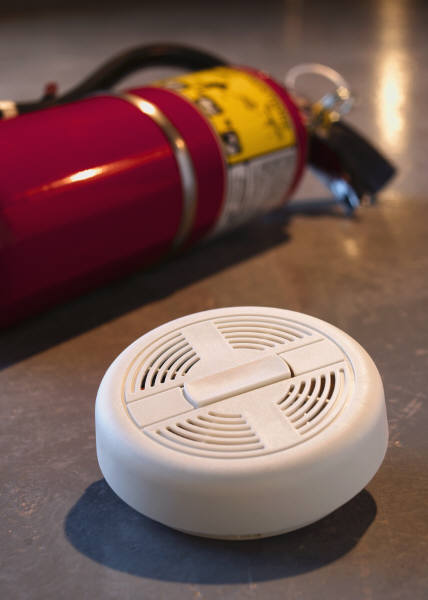
- Teach each family member how to use a fire extinguisher (ABC type), and show them the designated locations where they are kept in the house.
- Install smoke detectors on each level of your home, especially near bedrooms.
- Conduct a home hazard hunt.
- Stock emergency supplies and assemble a Disaster Supplies Kit.
- Take a Red Cross first aid and CPR class.
- Determine the best escape routes from your home. Find two ways out of each room.
- Find the safe spots in your home for each type of disaster, including your Shelter-in-Place spot.
4. Practice and Maintain Your Plan
- Quiz your children every six months so they remember what to do.
- Conduct fire and emergency evacuation drills.
- Replace stored water every three months and stored food every six months.
- Test and recharge your fire extinguisher(s) according to manufacturer's instructions.
- Test your smoke detectors monthly and replace the batteries the same weekend as the time change occurs in the spring (daylight-savings time) and fall (standard time).
EMERGENCY SUPPLIES
Keep enough supplies in your home to meet your needs for at least three days. Assemble a Disaster Supplies Kit with items you may need in an evacuation. Store these supplies in sturdy, easy-to-carry containers such as backpacks, duffle bags or covered plastic containers. Include:
- A three-day supply of water (one gallon per person per day) and food that won't spoil.

- One change of clothing and footwear per person, and one blanket or sleeping bag per person.
- A first aid kit that includes your family's prescription medications.
- Emergency tools, including a battery-powered radio, flashlight and plenty of extra batteries.
- An extra set of car keys and a credit card, cash or traveler's checks.
- Sanitation supplies.
- Special items for infant, elderly or disabled family members.
- An extra pair of glasses.
- Keep important family documents in a waterproof container. Keep a smaller kit in the trunk of your car.
UTILITIES
Locate the main electric fuse box, water service main and natural gas main. Learn how and when to turn these utilities off. Teach all responsible family members. Keep necessary tools near gas and water shut-off valves.
Remember, turn off the utilities only if you suspect the lines are damaged or if you are instructed to do so. If you turn the gas off, you will need a professional to turn it back on.
NEIGHBORS HELPING NEIGHBORS
Working with neighbors can save lives and property. Meet with your neighbors to plan how the neighborhood could work together after a disaster until help arrives. If you're a
member of a neighborhood organization, such as a home association or neighborhood watch group, introduce disaster preparedness as a new activity. Know your neighbors' special skills (e.g., medical, technical) and consider how you could help neighbors who have special needs, such as disabled and elderly persons. Make plans for child-care in case parents are unable to get home during the emergency.
HOME HAZARD HUNT
During a disaster, ordinary objects in your home can cause injury or damage. Anything that can move, fall, break or cause a fire is a home hazard. Inspect your home at least once a year and fix potential hazards.
Contact the Kearney Volunteer Fire Department to learn about home fire hazards.
EVACUATION
Evacuate immediately if told to do so:
- Listen to your battery-powered radio and follow the instructions of local emergency officials.
- Wear protective clothing and sturdy shoes.
- Take your family disaster supplies kit.
- Lock your home.
- Use travel routes specified by local authorities--don't use shortcuts because certain areas may be impassable or dangerous.
If you're sure you have time:
- If instructed to do so, shut off water, gas and electricity before leaving.
- Post a note telling others when you left and where you are going.
- Make arrangements for your pets.
IF DISASTER STRIKES
- If disaster strikes
Remain calm and patient. Put your plan into action.
- Check for injuries
Give first aid and get help for seriously injured people.
- Listen to your battery powered radio for news and instructions.
- Evacuate, if advised to do so. Wear protective clothing and sturdy shoes.
Check for damage in your home...
- Use flashlights--do not light matches or turn on electrical switches, if you suspect damage.

- Check for fires, fire hazards and other household hazards.
- Sniff for gas leaks, starting at the water heater. If you smell gas or suspect a leak, turn off the main gas valve, open windows, and get everyone outside quickly.
- Shut off any other damaged utilities.
- Clean up spilled medicines, bleaches, gasoline and other flammable liquids immediately.
Remember to...
- Confine or secure your pets.
- Call your family contact--do not use the telephone again unless it is a life-threatening emergency.
- Check on your neighbors, especially elderly or disabled persons.
- Make sure you have an adequate water supply in case service is cut off.
- Stay away from downed power lines.
The Federal Emergency Management Agency's Family Protection Program and the American Red Cross' Disaster Education Program are nationwide efforts to help citizens prepare for disasters of all types. For more information, please contact the Emergency Management office, or the Fort Kearney Chapter of the American Red Cross. Start planning now.
Pets & Animals in a Disaster
Whether it's a large-scale natural catastrophe or an unforeseen emergency that causes you to leave your home temporarily, everyone's family can benefit from having a household evacuation plan in place before disaster strikes.
Every disaster plan must include your pets!
The Humane Society of the United States (HSUS) offers the following tips to pet owners designing an emergency safety plan:
- If you evacuate your home, DO NOT LEAVE YOUR PETS BEHIND! Pets most likely cannot survive on their own; and if by some remote chance they do, you may not be able to find them when you return.
- For public health reasons, many emergency shelters cannot accept pets. Find out which motels and hotels in your area allow pets -- well in advance of needing them. Include your local animal shelter's number in your list of emergency numbers -- they might be able to provide information concerning pets during a disaster.
- Make sure identification tags are up to date and securely fastened to your pet's collar. If possible, attach the address and/or phone number of your evacuation site. If your pet gets lost, his tag is his ticket home. Make sure you have a current photo of your pet for identification purposes.
- Make sure you have a secure pet carrier, leash or harness for your pet so that if he panics, he can't escape.
- Take pet food, bottled water, medications, veterinary records, cat litter/pan, can opener, food dishes, first aid kit and other supplies with you in case they're not available later. While the sun is still shining, consider packing a "pet survival" kit, which could be easily deployed if disaster hits.
- If you are unable to return to your home right away, you may need to board your pet. Most boarding kennels, veterinarians and animal shelters will need your pet's medical records to make sure all vaccinations are current. Include copies in your "pet survival" kit along with a photo of your pet.
- If it is impossible to take your pet with you to temporary shelter, contact friends, family, veterinarians, or boarding kennels to arrange for care. Make sure medical and feeding information, food, medicine and other supplies accompany your pet to his foster home. NOTE: Some animal shelters will provide temporary foster care for owned pets in times of disaster, but this should be considered only as a last resort.
- If you have no alternative but to leave your pet at home, there are some precautions you must take, but remember that leaving your pet at home alone can place your animal in great danger! Confine your pet to a safe area inside -- NEVER leave your pet chained outside! Place a notice outside in a visible area, advising what pets are in the house and where they are located. Provide a phone number where you or a contact can be reached as well as the name and number of your vet.

Not only are pets affected by disaster, but the other animals in the disaster area are affected as well. The HSUS offers these basic tips for people who encounter wildlife or have livestock on their property:
Wildlife
- Wild animals often seek higher ground, which, during floods, eventually become submerged (i.e., island) and the animals become stranded. If the island is large enough and provides suitable shelter, you can leave food appropriate to the species (i.e., sunflower seeds for squirrels). Animals have a flight response and will flee from anyone approaching too closely. If the animal threatens to rush into the water, back away from the island or you may frighten the animal into jumping into the water to escape from you
- Wildlife often seek refuge from flood waters on upper levels of a home and may remain inside even after the water recedes. If you meet a rat or snake face to face, be careful but don't panic. Open a window or other escape route and the animal will probably leave on its own. Never attempt to capture a wild animal unless you have the training, protective clothing, restraint equipment and caging necessary to perform
the job.
- Beware of an increased number of snakes and other predators who will try to feed on the carcasses of small mammals who have been drowned or crushed in their burrows or under rocks.
- Often, during natural disasters, mosquitoes and dead animal carcasses may present disease problems. Outbreaks of disease may occur. The local public health office will issue news releases to assist with aiding the public regarding health issues associated with the disaster.
- If you see an injured or stranded animal in need of assistance, or you need help with evicting an animal from your home, please contact your local animal control office or Nebraska Games and Parks.
Livestock
Evacuate Livestock Whenever Possible.
- Arrangements for evacuation, including routes and host sites, should be made in advance. Alternate routes should be mapped out in case the planned route is inaccessible.
- The evacuation sites should have or be able to readily obtain food, water, veterinary care, handling equipment and facilities.
- Trucks, trailers, and other vehicles suitable for transporting livestock (appropriate for transporting each specific type of animal) should be available along with experienced handlers and drivers to transport them. Whenever possible, the animals should be accustomed to these vehicles in advance so they're less frightened and easier to move.
- If evacuation is not possible, a decision must be made whether to move large animals to available shelter or turn them outside. This decision should be determined based on the type of disaster and the soundness and location of the shelter (structure).
- All animals should have some form of identification that will help facilitate their return.
Your disaster plan should include a list of emergency phone numbers for local agencies that can assist you if disaster strikes -- including your veterinarian, state veterinarian, local animal shelter, animal care and control, and county extension service. These numbers should be kept with your disaster kit in a secure, but easily accessible place.
For additional information, please contact:
The Humane Society of the United States
2100 L. Street, NW
Washington, DC. 20037
Attn: Disaster Services Program
Phone: (202) 452-1100
Website: http://www.hsus.org
Winter Weather Preparedness
Each year, the National Weather Service issues numerous watches, warnings and advisories. Knowledge of those products is a critical element in winter weather preparations.
- Winter Storm Watch - Adverse winter weather (heavy snow, blizzard) is expected within the next two days, but the exact timing, location or occurrence of the storm is still uncertain. This is the time to get prepared for the storm.

- Winter Storm Warning - Hazardous winter weather is likely. If not already occurring, it is expected to occur within 6 to 24 hours. Travel will be hazardous, if not impossible. You should be ready for the storm by this time. Stay indoors!
- Blizzard Warning - The most dangerous of all winter weather will occur in your area. A combination of winds 35 mph or greater and significant snow and/or blowing snow with visibilities less than ¼ mile for three or more hours is expected in the warning area. Blinding snow ("white out"), deep drifts and life threatening wind chill will occur. Travel will be dangerous and should not be attempted. You should seek refuge immediately!
- Winter Weather Advisory - Winter weather conditions are expected to cause significant inconveniences and may be hazardous. If caution is exercised, these situations should not become life threatening. The greatest hazard is often to motorists.
Things to do at home or work BEFORE a winter storm strikes...
Primary concerns are the potential loss of heat, power, telephone service, and a shortage of supplies if storm conditions continue for more than a day.
Have available:
- Flashlight(s) and extra batteries.
- Battery-powered Weather Radio and portable radio. These are used to receive emergency information. They may be your only link to the outside.
- Extra food and water. High-energy food, such as dried fruit or candy, and food requiring no cooking or refrigeration is best.
- Extra medicine and baby items.
- First-aid supplies.
- Emergency heating source, such as a fireplace, wood stove, space heater, etc. Make sure you know how to uses the heating sources to prevent a fire and make sure you have proper ventilation.
- Fire extinguisher and smoke detector. Test units regularly
to ensure they are working properly. Replace batteries the same weekend as the time change occurs in the spring (daylight-savings time) and fall (standard time).
On the farm....
- Move animals to sheltered areas. Shelter-belts, properly laid out and oriented, are better protection for cattle than confining shelters, such as sheds.
- Haul extra feed to nearby feeding areas.
- Have a water supply available. Most animal deaths in winter storms are from dehydration.
- Heating fuel. Fuel carriers may not reach you for days after a severe winter storm. Stay alert to changing weather conditions throughout the winter to maintain an adequate fuel supply in advance of severe weather moving into the area.
WINTER PRECIPITATION TERMS:
Snow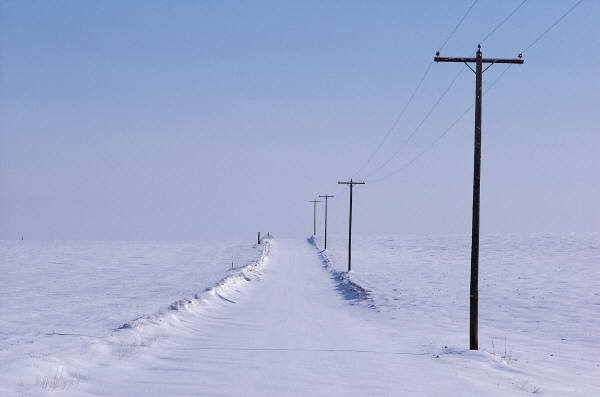
- Flurries - Light snow falling for short durations. No accumulation or light dusting is all that is expected.
- Showers - Snow falling at varying intensities for brief periods of time. Some accumulation is possible.
- Squalls - Brief, intense show showers accompanied by strong, gusty winds. Accumulation may be significant. Snow squalls are best known in the Great Lakes region.
- Blowing Snow - Wind-driven snow that reduces visibility and causes significant drifting. Blowing snow may be snow that is falling and/or loose snow on the ground picked up by the wind.
- Blizzard - Winds over 35 mph with snow and blowing snow reducing visibility to near zero.
Sleet
Is formed by raindrops that freeze into ice pellets before reaching the ground. Sleet usually bounces when hitting a surface and does not stick to objects. However, it can accumulate like snow and cause a hazard to motorists.
Freezing Rain
Is rain that falls onto a surface that has a temperature below freezing. This causes it to freeze to surfaces, such as trees, cars, and roads, forming a coating or glaze of ice. Even small accumulations of ice can cause a significant hazard.
Wind Chill
The wind chill is based on the rate of heat loss from exposed skin caused by combined effects of wind and cold. As the wind increases, heat is carried away from the body at an accelerated rate, driving down the body temperature. Animals are also affected by wind chill.
WINTER DRIVING
The leading cause of death during winter storms is transportation accidents. Preparing your vehicle for the winter season and knowing how to react if stranded or lost on the road are the keys to safe winter driving.
Have a mechanic check the following items on your car:
- Battery
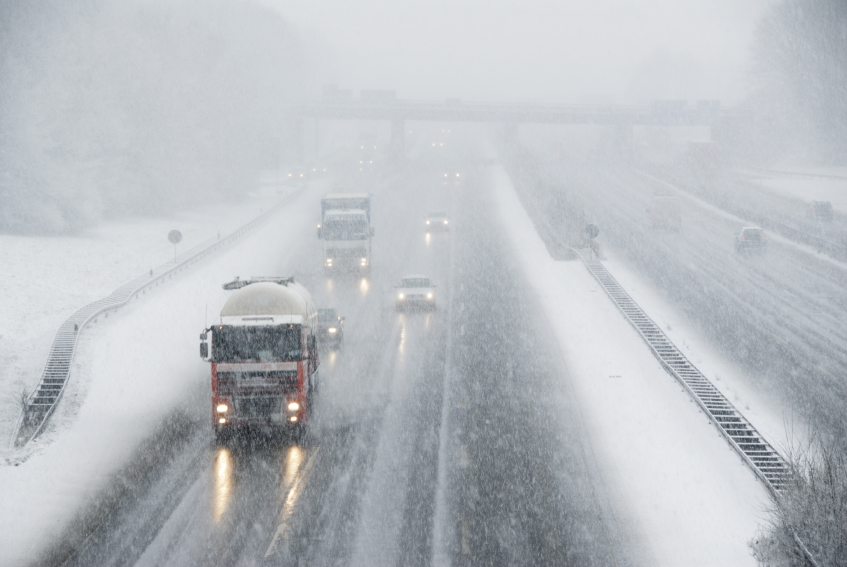
- Antifreeze
- Wipers and windshield washer fluid
- Ignition system
- Thermostat
- Lights
- Flashing hazard lights
- Exhaust system
- Heater
- Brakes
- Defroster
- Oil level (if necessary, replace existing oil with a winter grade oil or the SAE 10w/30 weight variety)
- Install good winter tires. Make sure the tires have adequate tread. All-weather radials are usually adequate for most winter conditions.
- Keep a windshield scraper and small broom for ice and snow
removal.
- Maintain at least a half tank of gas during the winter season.
- Plan long trips carefully. Listen to the radio or Call 511 from anywhere in Nebraska for Nebraska Traveler information for the latest road conditions. Always travel during daylight and, if possible, try not to travel alone.
- Let someone know your timetable and primary and alternate
routes.
- Dress to fit the season. Wear loose-fitting, light-weight, warm clothing in several layers. Trapped air insulates. Layers can be removed to avoid perspiration and subsequent chill. Outer garments should be tightly woven, water repellent and hooded. Wear a hat. Half your body heat loss can be from the head. Cover your mouth to protect your lungs from extreme cold. Mittens, snug at the wrist, are better than gloves. Try to stay dry.
- Carry food and water. Store a supply of high-energy "munchies" and several bottles of water.
Carry a WINTER STORM SURVIVAL KIT in your vehicle that includes:
- Flashlights with extra batteries
- First aid kit with pocket knife
- Necessary medications
- Several blankets
- Sleeping bags
- Extra newspapers for insulation
- Plastic bags (for sanitation)
- Matches
- Extra set of mittens, socks, and a wool cap
- Rain gear and extra clothes
- Small shovel
- Small sack of sand for generating traction under wheels
- Small tools (pliers, wrench, screwdriver)
- Booster cables
- Set of tire chains or traction mats
- Cards, games, and puzzles
- Brightly colored cloth for a flag
- Canned fruit and nuts
- Non-electric can opener
- Bottled water
IF TRAPPED IN CAR DURING A BLIZZARD:
- Stay in the car. Do not leave the car to search for assistance unless help is visible within 100 yards. You may become disoriented and lost in blowing and drifting snow.
- Display a trouble sign. Hang a brightly colored cloth on the radio antenna and raise the car hood.
- Occasionally run engine to keep warm. Turn on the car's engine for about 10 minutes each hour. Run the heater when the car is running. Also, turn on the car's dome light when the car is running. Beware of carbon monoxide poisoning. Keep the exhaust pipe clear of snow and open a downwind
window slightly for ventilation.
- Watch for signs of frostbite and hypothermia.
- Do minor exercises to keep up circulation. Clap hands and move arms and legs occasionally. Try not to stay in one position for too long.
- If more than one person is in the car, take turns sleeping.
- For warmth, huddle together. Use newspapers, maps, and even the removable car mats for added insulation.
- Avoid overexertion. Cold weather puts an added strain on the heart. Unaccustomed exercise such as shoveling snow or pushing a car can bring on a heart attack or make other medical conditions worse. Be aware of symptoms of dehydration.
|